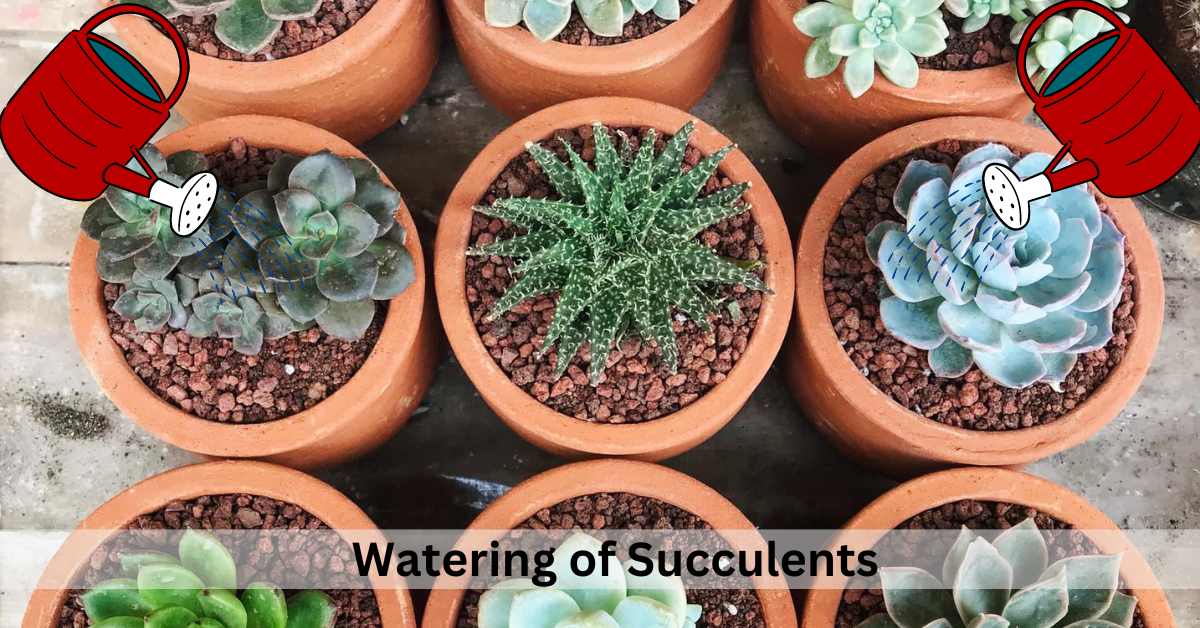Introduction
By the term Succulents, we understand the desert plants with fleshy, swollen modified stems or leaves for storage of water making them drought-resistant and can survive even in a limited supply of water. The word succulent itself comes from the Latin word ‘sulcus’, meaning juice or sap. Using succulents as the houseplant has been quite popular and is in trend these days. They are undoubtedly the easiest houseplants to take care of. But still, we can see many people failing at succulent care as they couldn’t provide the required amount of sunlight, water, and humidity. The problems in succulent care arise mostly due to watering problems. Both overwatering and underwatering are harmful to the succulents. However, over-watering is still the biggest problem among the succulent growers.
Some people want to treat their succulent houseplant as their other non-succulent houseplant which needs plenty of water and water their succulents daily. This misconception about succulent watering may lead to problems like water logging, damping off, root rot, stem rot, soggy discolored leaves, etc. It also invites fungal attacks and other diseases. The rot, if not controlled, slowly decays the stem or root and may even lead to the death of the plant. On the other side, some busy bees think succulents don’t need water at all and have not been drinking them barely for months. Underwatering is very rare as the plant can survive quite a time even in the absence of water. Underwatering if occurs may cause stunted growth, burning of leaves, reduced size and cracking of soil, etc. The plant cannot get enough nutrients after the exhaustion and the growth ceases.
You have to understand that both of these situations, i.e. overwatering and underwatering are very harmful for succulents. You need to master the required watering pattern and watering frequency of the succulents to master succulent care. In this article, we are going to address the problems in watering succulents and we are gonna help you diagnose and rescue your overwatered or under-watered succulents. Let’s dive right into it!
Overwatered vs Underwatered Succulent
To solve the problem, you have to first identify the problem. Likewise, you need to know if the plant is overwatered or underwatered to give proper water treatment to the plants. Here are a few differences that can make you identify underwatered and overwatered succulents. Check it out -:
| Overwatered succulent | Underwatered Succulent |
| You can see water logging on the surface of the soil. | You can see cracks formed on the surface of the soil. |
| Soft, mushy brown spots can be observed in the rot area. | The dried, wrinkled, shrivelled leaves and thin stems can be observed. |
| Leaves turn yellow and translucent. | You can see burnt, crispy leaves due to dehydration. |
| Overwatering causes almost all leaves to drop. | Underwatering causes the drop of lower dried leaves. |
| Fungal and factorial growth can be seen. | Underwatered succulent is not suitable for fungal growth. |
| It may be caused by dense, compact soil and low drainage. | It is almost caused by a lack of watering. |
| Overwatered succulent is difficult to revive. | Underwatered succulent revives easily. |
| You should decrease your watering frequency and create a well-aerated soil mix. | You should water the succulents timely for their fleshy and healthy growth. |
Overwatered Succulent

Succulents if watered more than their absorbing capacity or their requirement lead to overwatered succulents. You have to know that the succulent is a desert-suited plant and is used in arid environments with limited water supply. The succulents have a very shallow, loose, highly aerated, and fibrous root system. The potting soil for the succulents is designed to increase its drainage capacity by adding other materials like coarse sand, pumice, perlite, sphagnum moss, coconut coir, peat moss, bark shreds, etc. These inorganic materials along with some nutritious organic matter help the succulent hold the water for a longer period. We should remember even if we observe the upper part to be dry, there’s still the water at the soil bottom which is held by these drainage materials. So, don’t just water your succulent thinking it may require water if the top soil gets dry. If you water the succulents in this case, undoubtedly the succulents become overwatered.
Overwatered Succulent Signs
As we discussed, the succulents when watered even when their lowermost roots are still moist become overwatered succulents. But, How will you identify if the succulent is overwatered? You need to know some of the signs the plant shows if it gets overwatered. Here are a few,
- Waterlogged soil: You can see the water getting logged at the surface of the soil. The soil cannot absorb all the excess water and it gets logged there. You can see clumps of soil due to high moisture instead of friable grains of soil.
- Color of the leaves: You can see the bottom leaves changing their color. Usually, in many succulents like Echeveria agavoides Ebony, you can find many dry lower leaves. This is not due to watering problems but due to maturity. If overwatered, the lower bottom leaves turn pale and brown and look discolored. The overall upper leaves and stem look bloated and weak. The fleshy leaves lose their turgidity and become squishy. The new tissue grown in the leaves is very light, translucent, and brown due to overwatering breaking the turgid cells.

- Leaf drop: The bottom of the leaves becomes mushy, and slippery and loses its adhesion to the plant causing the leaf drop. You can observe quite a lot of leaves dropping down in case of overwatering.

- Succulent rot: Rot is the major sign of overwatering. You can see pale brownish or mushy yellow spots in leaves and Stems caused by rot when you overwater a succulent.
- Fungal growth: Overwatering means over moisture and yes, the most suitable environment for fungal growth. It invites fungal bodies when the rot gets severe. It can affect the color and growth of the succulent pretty fast.
How to Fix Overwatered Succulent

Fixing the overwatered succulent becomes easier if you can identify the overwatered succulents when the plant starts showing early signs of overwatering. The earlier you intervene, the greater chance you have of saving your favorite succulents. To fix the overwatered succulent, you need to identify the reason behind it. Not only excess water, but it may occur due to other factors listed below:
- Lack of drainage materials: If the potting soil is not well-draining, overwatering is likely to occur.
- Compact roots: Sometimes, the roots may get compacted and decrease the aeration inside the soil mix, leading to water logging at the top of the pot.
- Dense soil: The dense or clayey soil doesn’t drain easily, taking a longer time to pass the water down the roots and causing root suffocation and water logging at the top.
- Lack of drainage holes: Drainage holes are a prerequisite requirement for a succulent pot. The water gets logged down the roots and causes rots in the absence of drainage holes in the pot.
After identifying the reason for overwatering, you can now think of the solution according to the cause. If it is caused by insufficient drainage materials, add those materials like perlites, pumice, cocopeat, peat moss, etc. For the compact roots, loosen the roots while repotting by cutting down extra roots without affecting the main root. You can aerate the soil by mixing organic matter and inorganic drainage materials. Create drainage holes if not present in your succulent pots. And the most important of all, water only when it’s required. If the case gets severe, you need to repot the plant or propagate the new plant from its healthy remains.
Repotting Overwatered Succulent
You were successful in identifying the overwatering problem and are trying to retain the plant to its normal condition, but you find it’s not working.
What now?
No worries, we got your back. You can simply report the succulent in a new pot. Let me tell you, It’s easier than you imagine. Just follow the few simple steps below and get your succulent back to life:
- First, lightly squeeze or hit the side of the pot to separate the soil.
- Gently, shake out the succulent with its potting mix.
- Loosen the soaked soil away from the roots.
- Remove all the wet damp soil which is suffocating the roots.
- Take out the soggy, injured, discolored, dead, rotted, and infected parts of plants.
- In case of stem rot, you can cut the plant just above the rot and save the healthy leaves which can be propagated.
- The good healthy succulent with fleshy leaves, healthy stem, and white roots is left to dry out for a day or few days. Make sure to keep it out from direct sunlight as it may cause burn or dry it a little too much.
- Prepare a new well-draining succulent pot mix. You can refer to How to Make Best Succulent Soil Mix for its preparation.
- Choose a pot with drainage holes or earthen pots and insert the healthy plant remains into it. If you’re going to report in the same old pot, make sure to treat the pot for fungus and bacteria.
- Pour the prepared soil mix into the pot, and give it a light push downward.
- You can give a light watering and maintain a proper watering schedule so as not to overwater it yet again.
Problem Caused by Overwatering in Succulents
You may have already acknowledged most of the problems caused by overwatering while studying Overwatered Succulent Signs above. Let me list it out once again as a reminder to not overwater your succulent ,otherwise, you will be facing the problems listed below:
- Root and stem rot
- Fungal and bacterial growth
- Leaf drops
- Edema
- Discoloration of the plant.
- Lodging in case of tall plants.
- Bad smell from the decay of rotted leaves and suffocated soil.
For instance, Overwatering may cause yellow mushy leaves, leaf drops, root rot, and edema in succulents like String of Arrows.
Underwatered Succulent

Succulents if not watered to their requirement lead to underwatered succulents. Although the succulent is a desert-suited plant used in arid environments with limited water supply, it still needs irrigation in weeks or months intervals. The succulent potting soil has a high drainage capacity due to the presence of inorganic drainage materials like coarse sand, pumice, perlite, sphagnum moss, coconut coir, peat moss, bark shreds, etc. These inorganic materials along with some nutritious organic matter help the succulent hold the water for a longer time. Even if we see the dry upper part, there’s still the water at the soil bottom which is held by these drainage materials. So, you don’t need to water the succulents frequently. But in rare cases, you may find the succulent getting abandoned from watering leading to problems of underwatering in succulents.
Underwater Succulent Signs
The case of underwatering is rare but to identify this problem, you need to be aware of its signs. You can’t identify the underwatered succulent without going through its signs. Here we go:
- Dried, crispy leaves: The leaves turn dry and crisp in texture due to overheating.
- Stunted growth: The soil gets exhausted and the growth of succulents ceases due to a lack of nutrients.
- Shriveled and wrinkled leaves: Lack of water reduces the growth of plants and causes the leaves to shrivel and wrinkle.
- Bottom Leaf Drop: The bottom dried leaves tend to drop easily in underwatered succulents.
- Flaccid stems: The succulent loses its turgidity and the stems start to turn flaccid in water shortage.

- Aerial roots growth: Some succulents start to produce aerial roots in the air to search for moisture.
- Dusty and friable soil: The dehydrated soil becomes dusty and cracks can be seen.
- Discoloration of the plant: The plant starts turning brown due to dehydration and burning.
How to Save Underwatered Succulent?
Saving the underwatered succulent is not a big deal. You can revive the underwatered succulents very easily as long as the roots and leaves are not damaged severely. Like in overwatered succulents, let’s get acquainted with the probable cause of underwatered succulents first. It occurs mainly due to:
- Lack of watering: Delaying the watering for a long period leads to water exhaustion.
- Overexposure to sunlight: Sometimes keeping the succulent under direct sunlight for a longer period may lead to dehydration.
- Light, non-draining soil mix: If the soil mix is not well-draining, the water gets lost immediately after watering and the plant can’t retain it afterward.
Problem Caused by Underwatering in Succulents
As mentioned earlier, underwatering is not a big issue. You can revive it by:
- Removing the dried and burnt parts.
- Water therapy: Keeping the plant alone in water for a day can help bring the underwatered succulent back to its normal condition.
Still, it’s better to not let the event happen in the first place. You need to remember underwatering invites problems like
- Drying and dropping of leaves.
- Whole plants or some plant parts may turn brown losing their aesthetic appearance.
- Leaves get shriveled and wrinkled.
- Aerial roots make it lodge towards the moisture.
To take an example, you can see the shriveling of leaves as a major problem due to underwatering in succulents like String of Pearls.
How Often Should I Water My Succulents?
Well, the water requirement of succulents varies with the seasons and the intensity exposure you are giving it to. Usually, it is recommended to water the succulents once a month during the winter season and once a week or fortnight during the summer. The succulents kept outdoors need more water than the indoor succulents. For example, Echeveria agavoides Ebony requires one water application every 10 to 15 days depending on the moisture content in the soil.
The easiest method is to dip the finger into the soil and water it when about 2 inches deep of the soil feels dry.
Final Verdict
Watering the succulents is not much hassle. But sometimes, we still get diverted from our normal schedule and invite overwatering or underwatering problems. You need to check for overwatering on time. Reviving the succulent from the overwatering is a little hassle but not impossible. Though rare, underwatering also needs to be looked after. Try to observe your soil first to understand when to water. Once you master in watering your succulents properly, you can thoroughly enjoy raising your succulent.
FAQs
1. How do you fix overwatered succulents?
You can fix the overwatered succulents by repotting and letting the root get dry by removing the wet soil. If the rot is serious, you can propagate the healthy leaves.
2. How do you tell if a succulent is overwatered?
You can tell the overwatered succulent by the appearance of signs like yellow and mushy, translucent, discolored leaves, fungus growth, waterlogging at the soil surface, and leaves drop.
3. Can succulents survive being overwatered?
The overwatered succulent can survive for a few days until the rot hasn’t got severe. If not repotted till then, it’s difficult to revive it back.
4. Can a succulent recover from underwatering?
Yes, you can easily recover the succulent from underwatering. You can remove the burnt parts plant and give it water therapy for a day alone in water to revive it.
5. How do you tell if a succulent is under-watered?
You can tell an under-watered succulent by signs like crispy, wrinkled, dried, shriveled leaves, flaccid stem, and browning of the succulent.
6. How many days can a succulent go without water?
The succulents can go without water for a month in winter and almost 2 weeks in summer. It depends on the type of succulent and the season.
References
https://succulentsbox.com/blogs/blog/how-to-save-dying-succulents-part-1-overwatered-succulents
https://www.youtube.com/watch?v=u2dfYYIoPwM
https://www.youtube.com/watch?v=XSG3wlh263Q
https://sproutingflora.com/underwatered-succulents/


